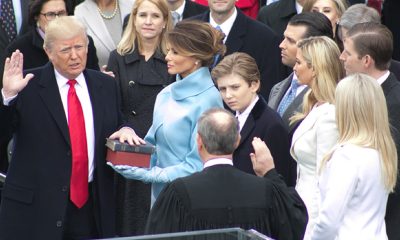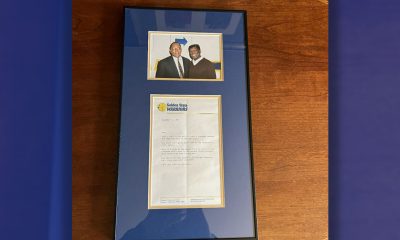Sports
With Longtime Powers Sidelined, NBA Playoffs Have Fresh Look

Houston Rockets guard James Harden (13) and guard Pablo Prigioni (9) react to a Harden 3-pointer against the Los Angeles Clippers during Game 2 in a second-round NBA basketball playoff series Wednesday, May 6, 2015, in Houston. The Rockets won 115-109. (AP Photo/Houston Chronicle, James Nielsen)
PAUL NEWBERRY, AP Sports Writer
Spurs and Celtics? Already eliminated.
Lakers and Heat? Didn’t even make the playoffs.
There’s a new look to this NBA postseason, which will crown a champion that hasn’t won the title in at least 17 years — or, quite possibly, a franchise that has never been on top.
“There is not just one dominant team,” Washington’s Bradley Beal said Thursday. “You’re not going to see the same teams.”
Indeed, of the eight conference semifinalists, the most recent to win a championship is the Chicago Bulls, who claimed the last of six Michael Jordan-era titles in 1998. The Houston Rockets are the only other multiple champion still playing, winning back-to-back titles in 1994-95.
There are two franchises that won their only championships so long ago, well, one had a different nickname (the Washington Wizards were the Bullets when they took the 1978 title) and another was in a different city (the 1958 St. Louis Hawks, who moved to Atlanta a decade later). The Golden State Warriors are 40 years removed from their lone championship season, but at least they’ve got a banner.
The Los Angeles Clippers, Cleveland Cavaliers and Memphis Grizzlies have never won a title.
“I don’t think there’s any question that fresh faces and new teams invigorate the sport,” Grizzlies general manager Chris Wallace said. “It adds new flavors for the fans to sample. And they like it. The game has never really been more popular on a global standpoint than it is right now.”
While the NBA was the first major North American league to put in a salary cap, it’s had the most exclusive group of champions. Over the last 16 years, just three teams — the Los Angeles Lakers, San Antonio Spurs and Miami Heat — have hogged a total of 13 titles.
Going back even farther to the launch of the modern NBA in 1950, two teams — the Boston Celtics, with 17 banners, and the Lakers, who have a total of 15 including their time in Minneapolis — account for nearly half the championships.
That’s why this season really stands out for the NBA.
“Whoever wins is going to be a brand new face,” Warriors coach Steve Kerr said. “That’s exciting for those of us who are still playing.”
Some possible reasons for this changing of the playoff guard:
TEAM BALL
San Antonio proved last year that a team doesn’t need a megastar to win the title, and plenty of teams are trying to follow the Spurs model.
Most notable is Atlanta, where the roster was expertly assembled by former Spurs executive Danny Ferry and the coach is Mike Budenholzer, a longtime assistant under San Antonio’s Gregg Popovich. The Hawks went 60-22 and claimed a top seed in the East for the first time since 1994 with an absurdly balanced lineup; the five starters averaged between 12 and 17 points a game.
Ball movement is now the order of the day, the isolation play largely viewed as a forgettable relic. With everyone sharing in this fast-paced style, it’s no longer necessary to have one of the five best players in the game to be a title contender.
“It’s more of a team game,” Hawks guard Jeff Teague said. “A team like us, that doesn’t have what you would call a superstar, can be a really good team.”
TOUGHER CAP
While the NBA first instituted a salary cap in the 1980s, it was long nothing more than an annoyance for the power franchises, which were still able to go after pretty much anyone they wanted.
The lockout of 2011 changed that. Under the current collective bargaining agreement, there are shorter contracts and tougher financial penalties for teams that spend too much.
While it’s still too early to know exactly how much this CBA will affect the competitive balance, the league touts the measures as a means to getting more teams in the mix (and making the owners a lot more profitable).
With franchises now selling for astronomical amounts, the players figure to push back on these measures the next chance they get. No matter what, it figures to have a long-term impact on the way rosters are built and maintained.
WHERE’S LEBRON
It still helps to have the best player in the world. And there’s no one better than LeBron James.
After heading to South Beach to join Dwyane Wade and Chris Bosh in 2010, James led Miami to four straight NBA Finals and two championships.
When James returned to Cleveland this season, the balance of power shifted northward. The Heat missed the playoffs, while the Cavaliers finished second in the East behind Atlanta.
Even with the King in the mix for another title, there will surely be a different look to the celebration.
“That’s what the NBA really wants,” Atlanta’s Kyle Korver said. “They want everyone to feel that if you manage your team well, put a good team together, coach them well and play hard, it doesn’t matter if you’re a big market or a small market. You’re going to have a chance.”
___
AP Sports Writers Teresa Walker in Nashville, Antonio Gonzalez in Oakland and Beth Harris in Los Angeles, and AP freelance writers Benjamin Standig in Washington and Clay Bailey in Memphis contributed to this report.
___
Follow Paul Newberry on Twitter at www.twitter.com/pnewberry1963
Copyright 2015 The Associated Press. All rights reserved. This material may not be published, broadcast, rewritten or redistributed.
Activism
McClymonds High Names School Gym for Star Graduate, Basketball Legend Bill Russell
William “Bill” Felton Russell was born on Feb. 12, 1934, and died on July 31, 2022. He achieved fame as a U.S. professional basketball player who played center for the Boston Celtics of the National Basketball Association (NBA) from 1956 to 1969. He was the centerpiece of the Celtics dynasty that won 11 NBA championships during his 13-year career.
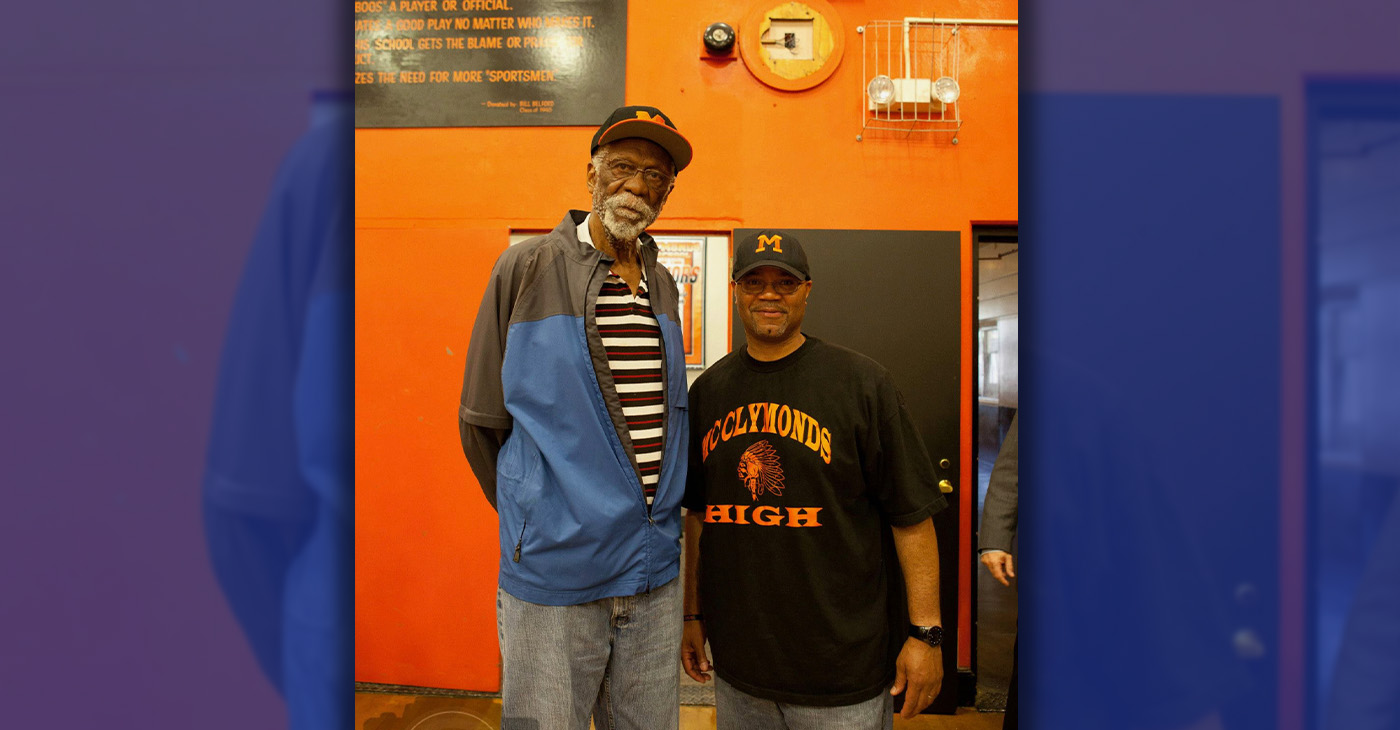
By Ken Epstein
West Oakland’s McClymonds High School, “the School of Champions,” this week named the school’s gymnasium in honor of one of its most famous graduates, basketball legend Bill Russell (class of ’52).
William “Bill” Felton Russell was born on Feb. 12, 1934, and died on July 31, 2022. He achieved fame as a U.S. professional basketball player who played center for the Boston Celtics of the National Basketball Association (NBA) from 1956 to 1969. He was the centerpiece of the Celtics dynasty that won 11 NBA championships during his 13-year career.
Russell is widely known as one of the greatest basketball players of all time. In 2011, he received the Presidential Medal of Freedom, the country’s highest civil honor, from President Barack Obama for Russell’s contributions to basketball and the Civil Rights Movement.
The McClymonds’ naming ceremony was held on Wednesday, the same day as Russell’s birthday. Oakland leader Bill Patterson, a longtime friend of Russell’s, was scheduled to cut the ribbon at the reopening of the gym, which had been closed for several months for renovation. Russell’s daughter Karen was scheduled to attend the ribbon cutting.
Russell’s name and signature are now printed on the gymnasium floor.
Patterson was working at DeFremery Park when he met Russell. “I befriended him as a boy and during his years at University of San Francisco” said Patterson. “We stayed friends for the rest of his life.”
Said McClymonds Principal Darielle Davis, herself a McClymonds graduate, “We are excited to honor Bill Russell for his sports accolades and because he broke color barriers. He is part of our legacy, and legacy is really important at McClymonds.”
Brian McGhee, community schools manager at McClymonds and former football player at UC Berkeley, said that Russell meant a lot to him and others at the school. “He was a beacon of light and hope for West Oakland,” he said. “He did a lot for sports and for civil rights.”
Starting in 2018, Ben “Coach” Tapscott worked with Patterson and other McClymonds grads, community members, and former coaches to encourage the Oakland Board of Education to endorse the naming of the school gym, which finally happened recently.
“We worked hard to make this happen,” said Tapscott. “He’s an important part of McClymond’s history, along with a lot of other famous graduates,” he said.
Activism
OPINION: Politics, Football and Identity in Trump’s America
If you haven’t noticed, all Americans are engaged in an even bigger game that means so much more than the Super Bowl. Our democracy is falling apart.
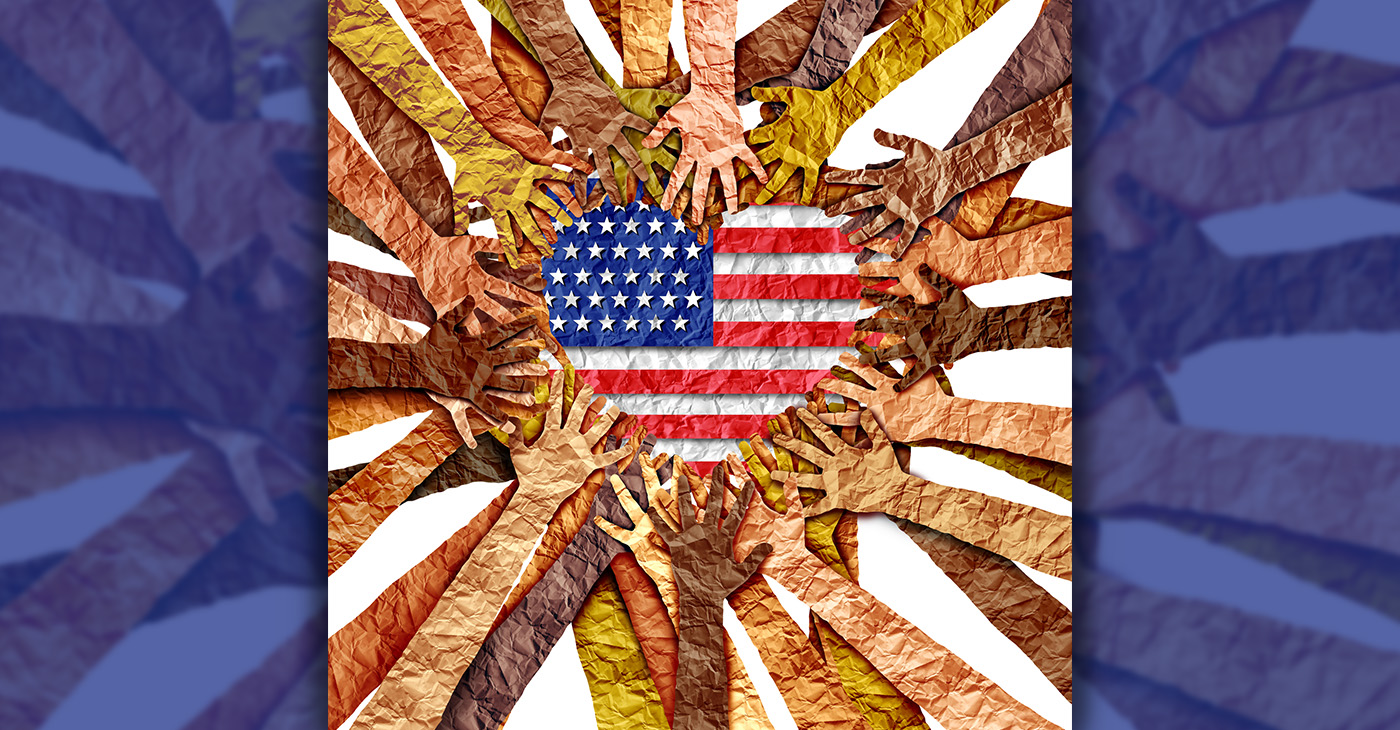
By Emil Guillermo
Two Filipino American stories made headlines recently.
First, Nikko Remigio, the Filipino and African American kick returner for the Kansas City Chiefs, did not win Super Bowl LIX.
The other, Alameda’s Rob Bonta said no to running for governor. I don’t blame him. It’s not like a mass of people wanted him to run.
But I did.
Whenever there is a Filipino American in a place you don’t expect, I’m rooting for that person.
As California’s Attorney General, Bonta is probably the most active defender among Blue States pushing back against Trump’s Extreme-Right agenda.
I’d like to Bonta run for California’s top job, but he’s better off waiting in line. The Democrats need a spot for Kamala Harris, and Bonta not running obliges the hierarchy.
History can wait. Bonta’s just 52.
Harris has held off speculation of her next move, saying she just moved back to the state. But it seems governor is the path for her.
For now, Bonta needs to continue taking the fight to Trump in the courts.
Football and Identity Politics
My dad, whose birthday would have been Super Bowl weekend, came to the US in 1928 as a colonized Filipino, an “American National,” where he couldn’t be a citizen, vote, own property or even marry the person he wanted.
Not if they were White.
Still, he believed in America. He never gave up.
Sort of like Nikko Remigio.
My dad would have loved Nikko.
If you haven’t noticed, all Americans are engaged in an even bigger game that means so much more than the Super Bowl. Our democracy is falling apart.
You want to get passionate about Eagles and Chiefs?
Let’s be passionate about our Founding Fathers, too.
Nikko didn’t change the game. He touched it three times and provided more yards than all of KC’s running backs.
That’s all I needed to see.
He’s our Filipino guy.
Detractors may call it “identity politics.”
People don’t seem to understand the fight for visibility. To be recognized. To be seen. It’s all wrapped up in the big idea of Civil Rights.
I was nowhere near as good as Nikko when I played. But when you are blessed to play football, you play your hardest.
For me, that was when I was 12 and 13 playing Pop Warner football in San Francisco. I was MVP for my team as a running back.
But I was ashamed of my dad. He wasn’t like the other dads. And I remember going to the team banquet to retrieve my trophy alone.
I didn’t realize it probably meant more to him than I thought.
I wish I had shared my MVP moment with him like Nikko shared his joy with his dad, Mark, born in Seattle to two Filipino immigrants, and his mom, whose mixture of Black and White made Nikko the picture of diversity.
Filipino American and Black and White at the Super Bowl.
But don’t forget, there is one game bigger.
The Super Bowl for Democracy. We’re battling for it every day Trump pushes a cockamamie idea that shakes the foundation of our Democracy.
About the Author
Emil Guillermo is an award-winning journalist and commentator. Watch his micro-talk show “Emil Amok’s Takeout/What Does an Asian American Think?” on www.YouTube.com/emilamok1 Or join him on http://www.patreon.com/emilamok
Bay Area
Tina Thompson: Champion, Legend, and Pioneer of Women’s Basketball
Known for her signature red lipstick, Thompson displayed confidence and style on the court, becoming an icon both for her gameplay and her individuality. Her ability to score from anywhere on the floor, combined with her defensive prowess, made her one of the league’s most formidable players.
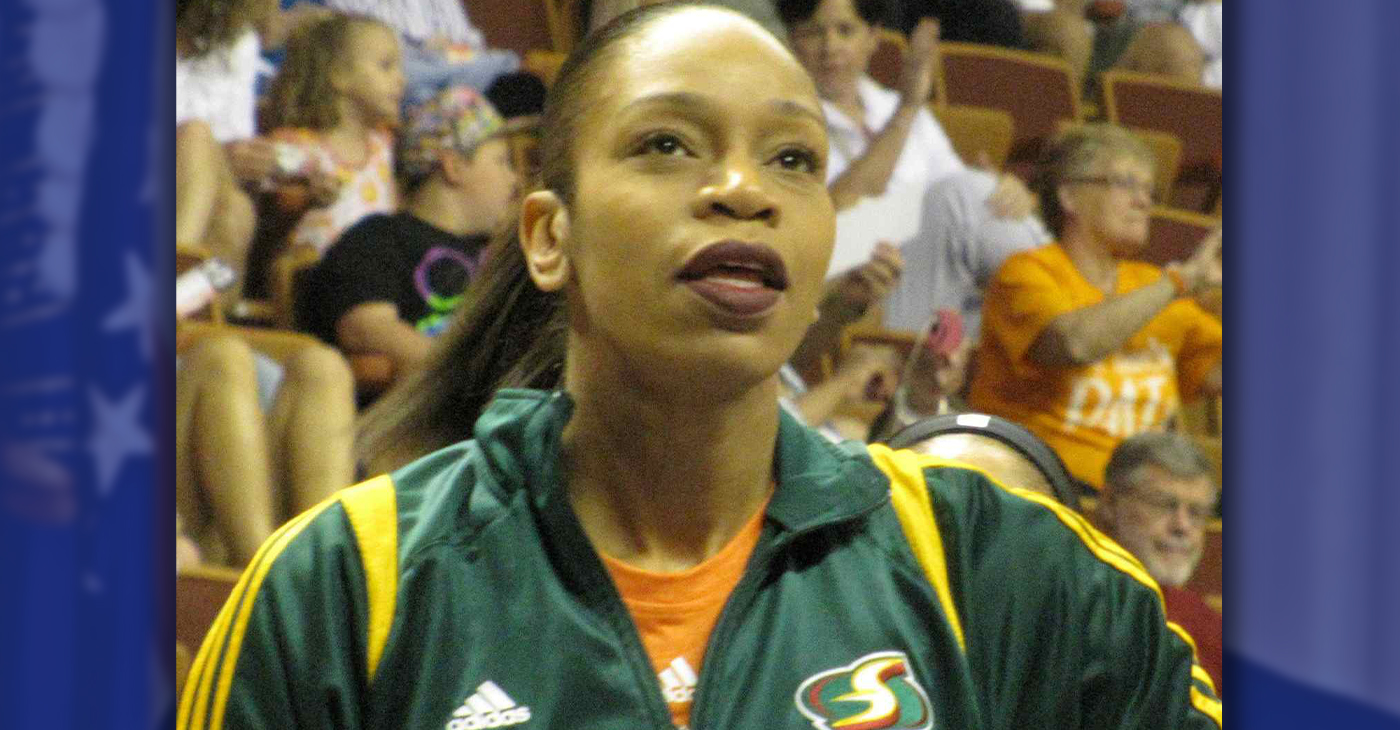
By Tamara Shiloh
The establishment of the Women’s National Basketball Association (WNBA) in 1996 was a turning point for women’s sports, creating a professional platform for female basketball players to showcase their skills at the highest level. Among the trailblazers who helped launch the league, Tina Thompson stands out as the first African American woman drafted into the WNBA.
Tina Thompson was born on February 10, 1975, in Los Angeles, California. Raised in a basketball-loving household, she quickly developed a passion for the game. Thompson improved her skills on the playgrounds of South Central Los Angeles, often playing against boys, which toughened her game and fueled her competitive edge.
She attended the University of Southern California (USC), where she became a standout player for the Trojans. Known for her versatility, scoring ability, and relentless work ethic, she earned All-Pac-10 honors multiple times and cemented her reputation as one of the top collegiate players in the nation.
When the WNBA held its first-ever draft on April 28, 1997, Tina Thompson made history as the league’s first African American player to be drafted. Selected as the first overall pick by the Houston Comets, she joined a team that would go on to dominate the early years of the WNBA.
Tina’s selection was a historic moment, symbolizing the league’s commitment to showcasing diverse talent. As a Black woman in a pioneering role, Thompson carried the hopes of aspiring African American female athletes who dreamed of playing professional basketball.
Tina wasted no time making an impact in the WNBA. As a key member of the Houston Comets alongside legends Cynthia Cooper and Sheryl Swoopes, she helped lead the team to an unprecedented four consecutive championships from 1997 to 2000. The Comets’ dynasty became the gold standard for excellence in the league’s early years.
Known for her signature red lipstick, Thompson displayed confidence and style on the court, becoming an icon both for her gameplay and her individuality. Her ability to score from anywhere on the floor, combined with her defensive prowess, made her one of the league’s most formidable players.
Over a career spanning 17 seasons, Tina established herself as one of the WNBA’s all-time greats. She retired as the league’s leading scorer, a record she held until it was broken by Diana Taurasi. She was a nine-time WNBA All-Star and was named to multiple All-WNBA teams, cementing her status as one of the sport’s legends.
In 2018, Thompson’s contributions to basketball were recognized with her induction into the Naismith Memorial Basketball Hall of Fame. The honor underscored her influence not just as a player, but as a trailblazer for African American women in sports.
After retiring from professional basketball, she transitioned into coaching, using her experience and knowledge to mentor young athletes. She has served as a head coach at the collegiate level, inspiring the next generation of players to pursue excellence both on and off the court.
As a role model and advocate, Thompson has consistently emphasized the importance of education, empowerment, and self-belief. Her story resonates with countless young women who see in her the embodiment of perseverance and success.
Tina Thompson is presently in her third season as an assistant coach at the University of Texas at Austin.
-
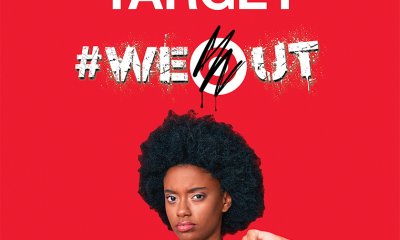
 #NNPA BlackPress3 weeks ago
#NNPA BlackPress3 weeks agoTarget Takes a Hit: $12.4 Billion Wiped Out as Boycotts Grow
-

 Activism3 weeks ago
Activism3 weeks agoUndocumented Workers Are Struggling to Feed Themselves. Slashed Budgets and New Immigration Policies Bring Fresh Challenges
-

 #NNPA BlackPress3 weeks ago
#NNPA BlackPress3 weeks agoBREAKING Groundbreaking Singer Angie Stone Dies in Car Accident at 63
-

 Activism3 weeks ago
Activism3 weeks agoOakland Post: Week of February 26 – March 4, 2025
-

 #NNPA BlackPress3 weeks ago
#NNPA BlackPress3 weeks agoApple Shareholders Reject Effort to Dismantle DEI Initiatives, Approve $500 Billion U.S. Investment Plan
-

 #NNPA BlackPress3 weeks ago
#NNPA BlackPress3 weeks agoNAACP Legend and Freedom Fighter Hazel Dukes Passes
-

 #NNPA BlackPress3 weeks ago
#NNPA BlackPress3 weeks agoSeniors Beware: O’Malley Says Trump-Musk Cuts Will Cripple Social Security
-

 #NNPA BlackPress3 weeks ago
#NNPA BlackPress3 weeks agoTrump Kicks the Ukrainian President Out of the White House

